tire pressure BMW X3 2.5I 2005 E83 Owner's Manual
[x] Cancel search | Manufacturer: BMW, Model Year: 2005, Model line: X3 2.5I, Model: BMW X3 2.5I 2005 E83Pages: 126, PDF Size: 4.65 MB
Page 50 of 126
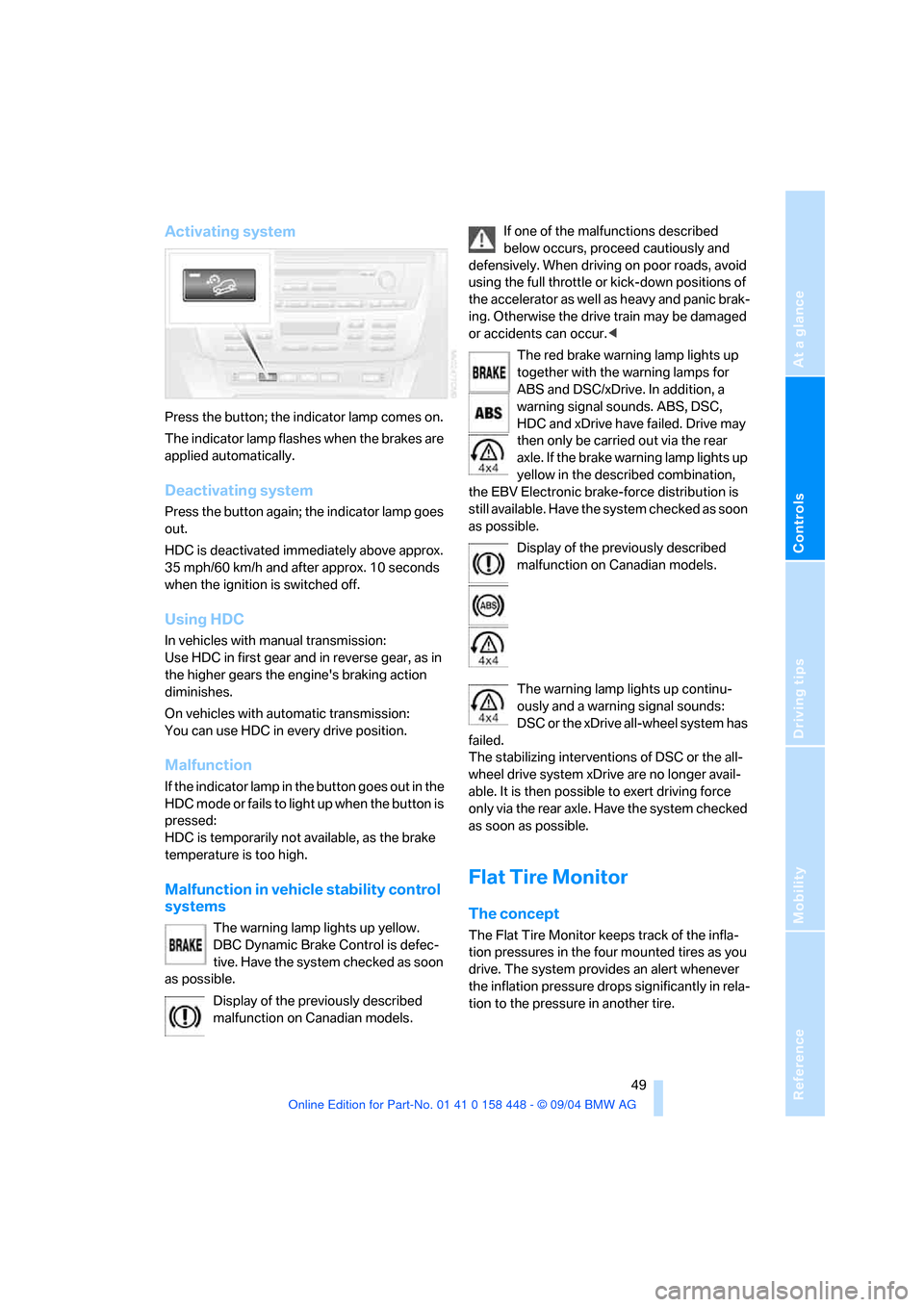
Reference
At a glance
Controls
Driving tips
Mobility
49
Activating system
Press the button; the indicator lamp comes on.
The indicator lamp flashes when the brakes are
applied automatically.
Deactivating system
Press the button again; the indicator lamp goes
out.
HDC is deactivated immediately above approx.
35 mph/60 km/h and after approx. 10 seconds
when the ignition is switched off.
Using HDC
In vehicles with manual transmission:
Use HDC in first gear and in reverse gear, as in
the higher gears the engine's braking action
diminishes.
On vehicles with automatic transmission:
You can use HDC in every drive position.
Malfunction
If the indicator lamp in the button goes out in the
HDC mode or fails to light up when the button is
pressed:
HDC is temporarily not available, as the brake
temperature is too high.
Malfunction in vehicle stability control
systems
The warning lamp lights up yellow.
DBC Dynamic Brake Control is defec-
tive. Have the system checked as soon
as possible.
Display of the previously described
malfunction on Canadian models.If one of the malfunctions described
below occurs, proceed cautiously and
defensively. When driving on poor roads, avoid
using the full throttle or kick-down positions of
the accelerator as well as heavy and panic brak-
ing. Otherwise the drive train may be damaged
or accidents can occur.<
The red brake warning lamp lights up
together with the warning lamps for
ABS and DSC/xDrive. In addition, a
warning signal sounds. ABS, DSC,
HDC and xDrive have failed. Drive may
then only be carried out via the rear
axle. If the brake warning lamp lights up
yellow in the described combination,
the EBV Electronic brake-force distribution is
still available. Have the system checked as soon
as possible.
Display of the previously described
malfunction on Canadian models.
The warning lamp lights up continu-
ously and a warning signal sounds:
DSC or the xDrive all-wheel system has
failed.
The stabilizing interventions of DSC or the all-
wheel drive system xDrive are no longer avail-
able. It is then possible to exert driving force
only via the rear axle. Have the system checked
as soon as possible.
Flat Tire Monitor
The concept
The Flat Tire Monitor keeps track of the infla-
tion pressures in the four mounted tires as you
drive. The system provides an alert whenever
the inflation pressure drops significantly in rela-
tion to the pressure in another tire.
Page 51 of 126

Technology for comfort, convenience and safety
50 The check of the tire inflation pressure is based
on monitoring the relative speeds of the wheels.
A flat tire is detected and reported on the basis
of a deviation in certain speed ratios.
Functional requirement
So that the Flat Tire Monitor can learn the cor-
rect inflation pressure, please perform the fol-
lowing steps:
1.Check the inflation pressures in all tires
2.Compare with the inflation pressure table
on page83 and correct if necessary
3.Initialize the system.
System limits
The Flat Tire Monitor cannot indicate
sudden severe tire damage caused by
outside factors and does not detect a natural,
even pressure drop in all four tires.<
In the following situations, on the other hand,
there can be delays in detecting tire pressure
losses, and even system failure:
>When driving on snow-covered or slippery
road surfaces.
>In the case of performance-oriented driving:
slip in the drive wheels, high lateral acceler-
ation.
>False alarms and undetected loss of pres-
sure may occur when you are driving with
snow chains fitted.
>When driving with a compact wheel, the Flat
Tire Monitor cannot operate.
Initializing system
Perform the initialization immediately
every time you correct the inflation pres-
sure, change a tire or change a wheel or all
wheels. This requires a trip.<1.Start the engine, but do not begin to drive.
2.Press the button until the yellow indicator
lamp in the instrument cluster lights up for a
few seconds.
3.Begin driving.
It takes a few minutes until the Flat Tire Monitor
can detect and indicate a flat tire.
Do not initialize the system when driving
with snow chains or with a compact
wheel.<
Indication of a flat tire
The warning lamp lights up yellow.
There is a flat tire or extensive inflation
pressure loss.
1.Reduce speed and stop the vehicle care-
fully. Avoid sudden braking and steering
maneuvers.
2.Identify damaged tire.
If identification is not possible, con-
tact your BMW Sports Activity Vehi-
cle Center.<
3.Replace the damaged wheel, refer to
Changing a wheel on page99.
Brake Force Display
The Brake Force Display lights up in two
stages, depending on how heavily you brake.
Page 74 of 126

Reference
At a glance
Controls
Driving tips
Mobility
73
Hot exhaust system
As in all vehicles equipped with a catalytic
converter, extremely high temperatures
are generated in this vehicle. Do not remove the
heat shields installed adjacent to various sec-
tions of the exhaust system, and never apply
undercoating to them. When driving, standing
at idle and while parking take care to avoid pos-
sible contact between the hot exhaust system
and any highly flammable materials such as hay,
leaves, grass, etc. Such contact could lead to
a fire, resulting in serious personal injury and
property damage.<
Mobile communications devices in
vehicle
BMW does not recommend using mobile
communications devices, e.g. portable
phones, in the interior of the vehicle without a
direct connection to an outside antenna. Other-
wise the vehicle electronics and mobile com-
munications device can affect each other. In
addition, there is no assurance that the radia-
tion which results during transmission will be
dissipated from the vehicle interior.<
Inside rearview mirror, automatically
dimming*
The inside rearview mirror contains two photo-
cells that control the automatic dimming func-
tion. One is integrated into the mirror glass, the
other is located on the back of the mirror.
For trouble-free operation, keep the photocells
clean and do not cover the area between the
interior rearview mirror and the windshield. Do
not attach any kind of stickers on the windshield
in front of the mirror, either.
When the vehicle is parked
Condensation forms in the air conditioner sys-
tem during operation, and then exits under the
vehicle. Traces of condensed water under the
vehicle are thus normal.
Before driving into a car wash
Fold in the exterior mirrors, refer to page28, as
otherwise they could be damaged due to the
width of the vehicle.
Deactivate the rain sensor as otherwise dam-
age could result from undesired wiper activa-
tion, refer to page39.
Hydroplaning
When driving on wet or slushy roads,
reduce road speed. If you do not, a wedge
of water can form between tires and road sur-
face. This phenomenon is referred to as hydro-
planing, and is characterized by a partial or
complete loss of contact between tires and
road surface, ultimately undermining your abil-
ity to steer and brake the vehicle.<
Driving through water
Do not drive through water on the road if it
is deeper than 20 in/50 cm, and then only
at walking speed. Otherwise, the vehicle's
engine, the electrical systems and the trans-
mission may be damaged.<
Use handbrake on inclines
Do not hold the vehicle in place on slopes
by slipping or riding the clutch, use the
handbrake instead. Otherwise greater clutch
wear will result.<
Safe braking
Your BMW is equipped with ABS as standard
equipment. The best way to brake is to apply
maximum pressure to the brake pedal during
emergency: panic braking. Since the vehicle
maintains steering responsiveness, you can
nevertheless avoid possible obstacles with a
minimum of steering effort.
Page 75 of 126
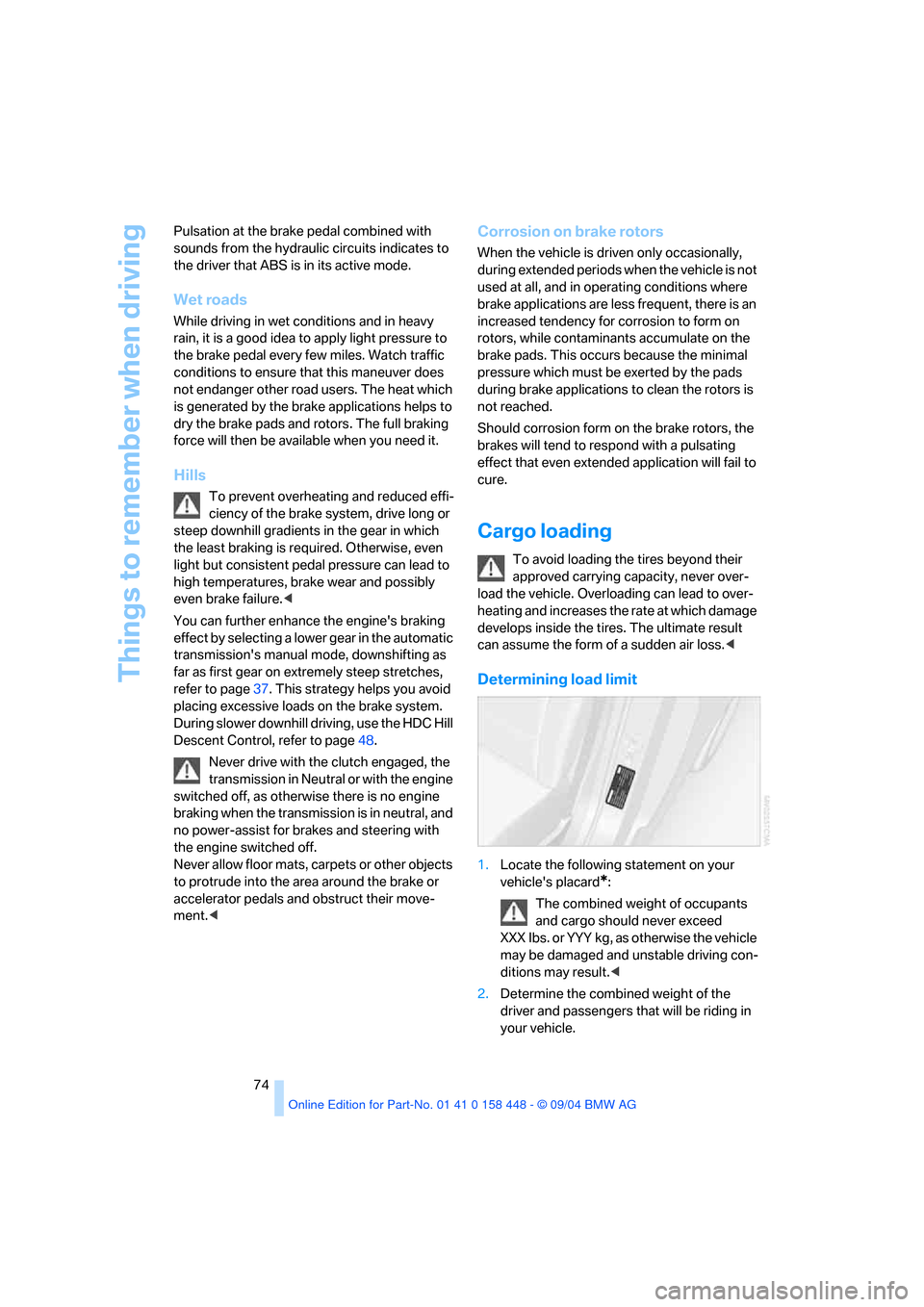
Things to remember when driving
74 Pulsation at the brake pedal combined with
sounds from the hydraulic circuits indicates to
the driver that ABS is in its active mode.
Wet roads
While driving in wet conditions and in heavy
rain, it is a good idea to apply light pressure to
the brake pedal every few miles. Watch traffic
conditions to ensure that this maneuver does
not endanger other road users. The heat which
is generated by the brake applications helps to
dry the brake pads and rotors. The full braking
force will then be available when you need it.
Hills
To prevent overheating and reduced effi-
ciency of the brake system, drive long or
steep downhill gradients in the gear in which
the least braking is required. Otherwise, even
light but consistent pedal pressure can lead to
high temperatures, brake wear and possibly
even brake failure.<
You can further enhance the engine's braking
effect by selecting a lower gear in the automatic
transmission's manual mode, downshifting as
far as first gear on extremely steep stretches,
refer to page37. This strategy helps you avoid
placing excessive loads on the brake system.
During slower downhill driving, use the HDC Hill
Descent Control, refer to page48.
Never drive with the clutch engaged, the
transmission in Neutral or with the engine
switched off, as otherwise there is no engine
braking when the transmission is in neutral, and
no power-assist for brakes and steering with
the engine switched off.
Never allow floor mats, carpets or other objects
to protrude into the area around the brake or
accelerator pedals and obstruct their move-
ment.<
Corrosion on brake rotors
When the vehicle is driven only occasionally,
during extended periods when the vehicle is not
used at all, and in operating conditions where
brake applications are less frequent, there is an
increased tendency for corrosion to form on
rotors, while contaminants accumulate on the
brake pads. This occurs because the minimal
pressure which must be exerted by the pads
during brake applications to clean the rotors is
not reached.
Should corrosion form on the brake rotors, the
brakes will tend to respond with a pulsating
effect that even extended application will fail to
cure.
Cargo loading
To avoid loading the tires beyond their
approved carrying capacity, never over-
load the vehicle. Overloading can lead to over-
heating and increases the rate at which damage
develops inside the tires. The ultimate result
can assume the form of a sudden air loss.<
Determining load limit
1.Locate the following statement on your
vehicle's placard
*:
The combined weight of occupants
and cargo should never exceed
XXX Ibs. or YYY kg, as otherwise the vehicle
may be damaged and unstable driving con-
ditions may result.<
2.Determine the combined weight of the
driver and passengers that will be riding in
your vehicle.
Page 83 of 126
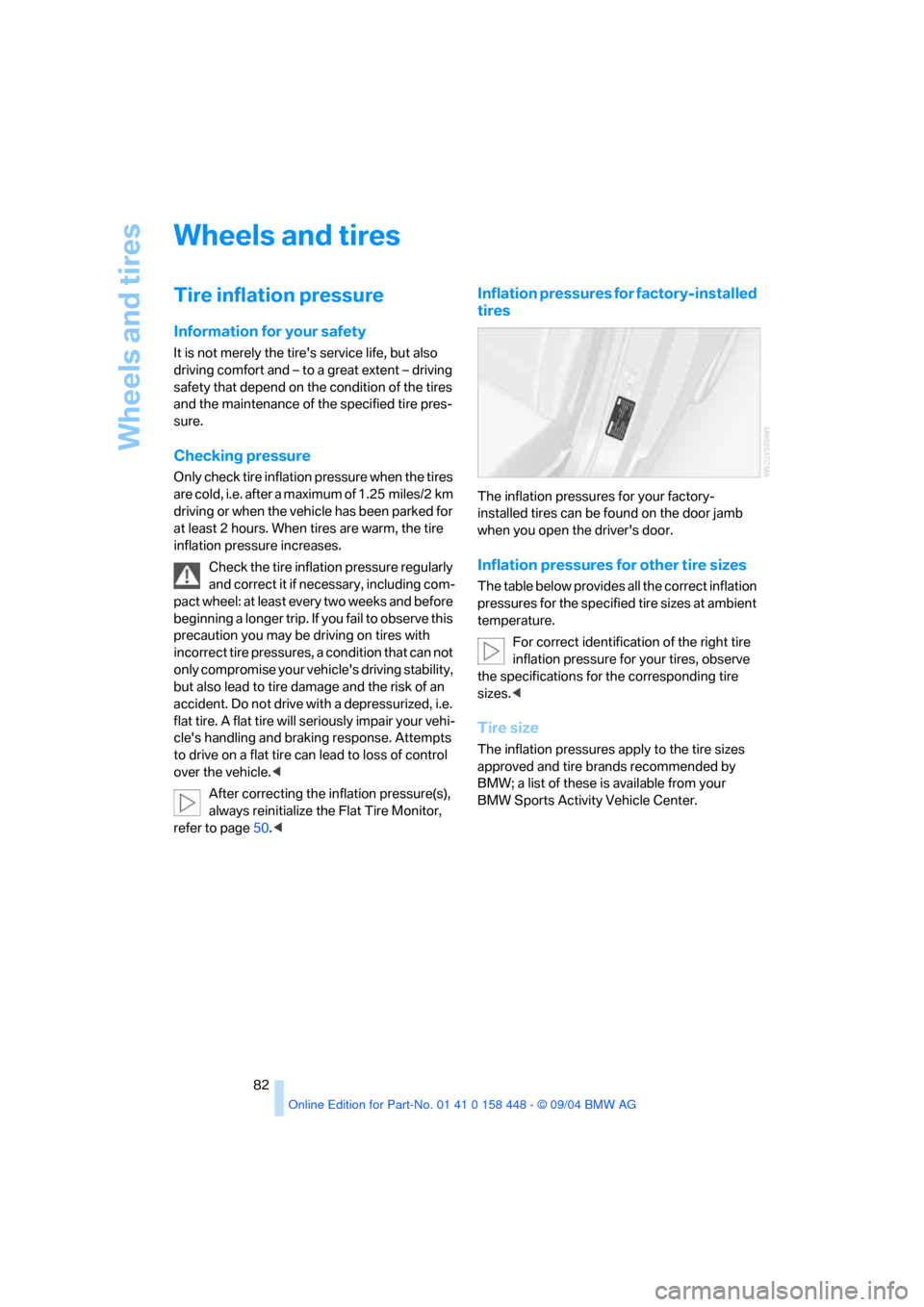
Wheels and tires
82
Wheels and tires
Tire inflation pressure
Information for your safety
It is not merely the tire's service life, but also
driving comfort and – to a great extent – driving
safety that depend on the condition of the tires
and the maintenance of the specified tire pres-
sure.
Checking pressure
Only check tire inflation pressure when the tires
are cold, i.e. after a maximum of 1.25 miles/2 km
driving or when the vehicle has been parked for
at least 2 hours. When tires are warm, the tire
inflation pressure increases.
Check the tire inflation pressure regularly
and correct it if necessary, including com-
pact wheel: at least every two weeks and before
beginning a longer trip. If you fail to observe this
precaution you may be driving on tires with
incorrect tire pressures, a condition that can not
only compromise your vehicle's driving stability,
but also lead to tire damage and the risk of an
accident. Do not drive with a depressurized, i.e.
flat tire. A flat tire will seriously impair your vehi-
cle's handling and braking response. Attempts
to drive on a flat tire can lead to loss of control
over the vehicle.<
After correcting the inflation pressure(s),
always reinitialize the Flat Tire Monitor,
refer to page50.<
Inflation pressures for factory-installed
tires
The inflation pressures for your factory-
installed tires can be found on the door jamb
when you open the driver's door.
Inflation pressures for other tire sizes
The table below provides all the correct inflation
pressures for the specified tire sizes at ambient
temperature.
For correct identification of the right tire
inflation pressure for your tires, observe
the specifications for the corresponding tire
sizes.<
Tire size
The inflation pressures apply to the tire sizes
approved and tire brands recommended by
BMW; a list of these is available from your
BMW Sports Activity Vehicle Center.
Page 84 of 126
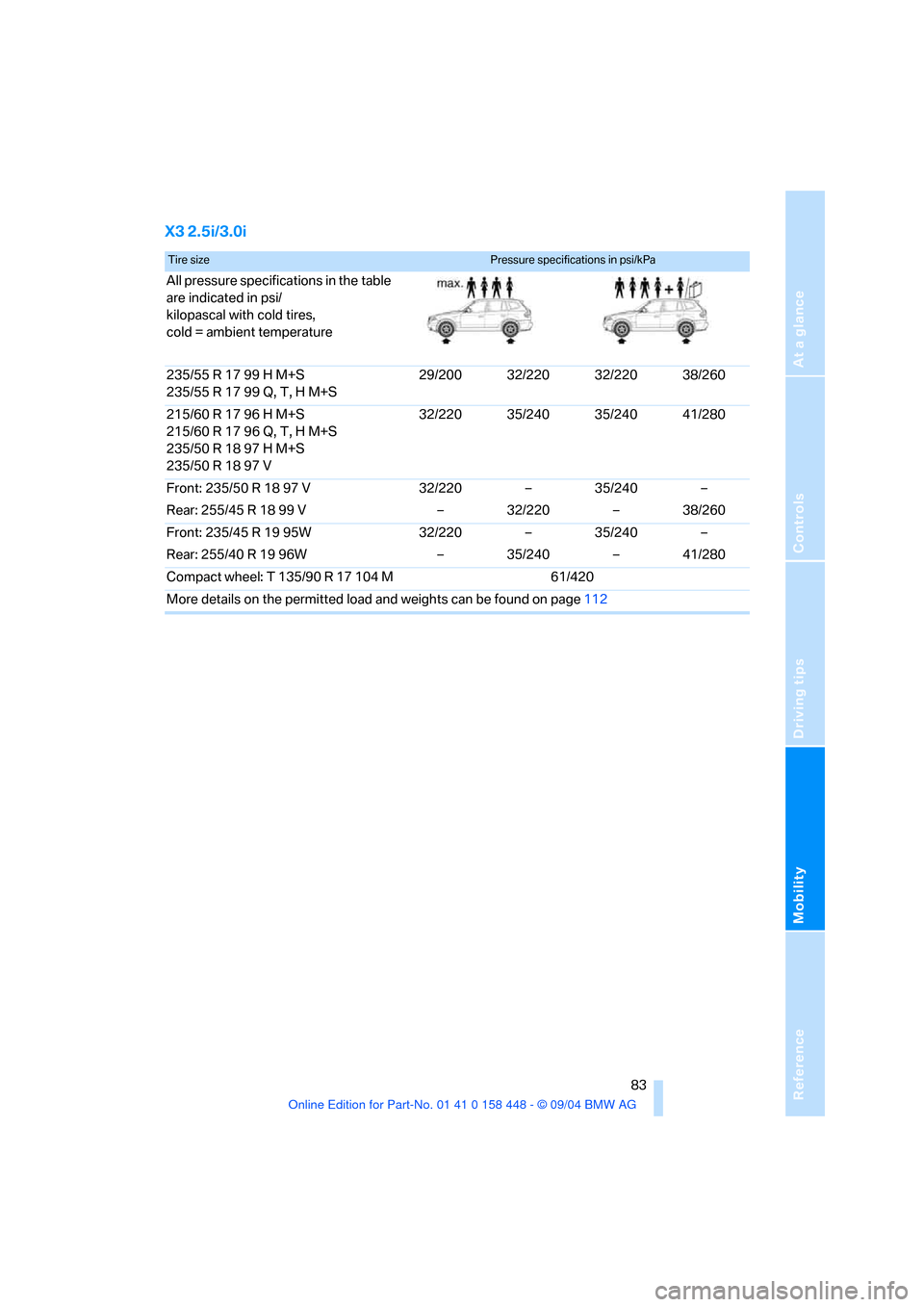
Reference
At a glance
Controls
Driving tips
Mobility
83
X3 2.5i/3.0i
Tire sizePressure specifications in psi/kPa
All pressure specifications in the table
are indicated in psi/
kilopascal with cold tires,
cold = ambient temperature
235/55 R 17 99 H M+S
235/55 R 17 99 Q, T, H M+S29/200 32/220 32/220 38/260
215/60 R 17 96 H M+S
215/60 R 17 96 Q, T, H M+S
235/50 R 18 97 H M+S
235/50 R 18 97 V32/220 35/240 35/240 41/280
Front: 235/50 R 18 97 V
Rear: 255/45 R 18 99 V32/220
––
32/22035/240
––
38/260
Front: 235/45 R 19 95W
Rear: 255/40 R 19 96W32/220
––
35/24035/240
––
41/280
Compact wheel: T 135/90 R 17 104 M 61/420
More details on the permitted load and weights can be found on page112
Page 86 of 126
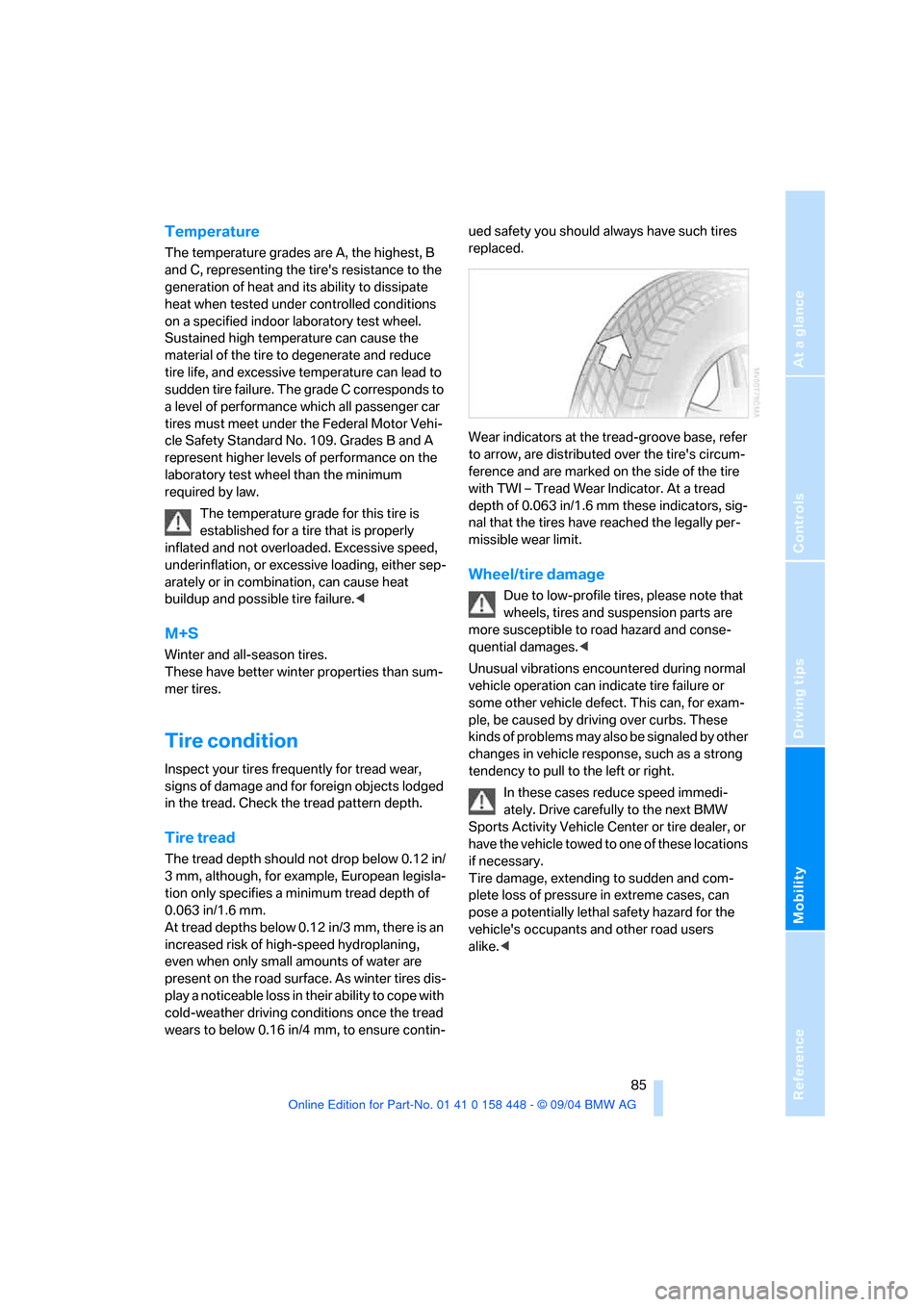
Reference
At a glance
Controls
Driving tips
Mobility
85
Temperature
The temperature grades are A, the highest, B
and C, representing the tire's resistance to the
generation of heat and its ability to dissipate
heat when tested under controlled conditions
on a specified indoor laboratory test wheel.
Sustained high temperature can cause the
material of the tire to degenerate and reduce
tire life, and excessive temperature can lead to
sudden tire failure. The grade C corresponds to
a level of performance which all passenger car
tires must meet under the Federal Motor Vehi-
cle Safety Standard No. 109. Grades B and A
represent higher levels of performance on the
laboratory test wheel than the minimum
required by law.
The temperature grade for this tire is
established for a tire that is properly
inflated and not overloaded. Excessive speed,
underinflation, or excessive loading, either sep-
arately or in combination, can cause heat
buildup and possible tire failure.<
M+S
Winter and all-season tires.
These have better winter properties than sum-
mer tires.
Tire condition
Inspect your tires frequently for tread wear,
signs of damage and for foreign objects lodged
in the tread. Check the tread pattern depth.
Tire tread
The tread depth should not drop below 0.12 in/
3 mm, although, for example, European legisla-
tion only specifies a minimum tread depth of
0.063 in/1.6 mm.
At tread depths below 0.12 in/3 mm, there is an
increased risk of high-speed hydroplaning,
even when only small amounts of water are
present on the road surface. As winter tires dis-
play a noticeable loss in their ability to cope with
cold-weather driving conditions once the tread
wears to below 0.16 in/4 mm, to ensure contin-ued safety you should always have such tires
replaced.
Wear indicators at the tread-groove base, refer
to arrow, are distributed over the tire's circum-
ference and are marked on the side of the tire
with TWI – Tread Wear Indicator. At a tread
depth of 0.063 in/1.6 mm these indicators, sig-
nal that the tires have reached the legally per-
missible wear limit.
Wheel/tire damage
Due to low-profile tires, please note that
wheels, tires and suspension parts are
more susceptible to road hazard and conse-
quential damages.<
Unusual vibrations encountered during normal
vehicle operation can indicate tire failure or
some other vehicle defect. This can, for exam-
ple, be caused by driving over curbs. These
kinds of problems may also be signaled by other
changes in vehicle response, such as a strong
tendency to pull to the left or right.
In these cases reduce speed immedi-
ately. Drive carefully to the next BMW
Sports Activity Vehicle Center or tire dealer, or
have the vehicle towed to one of these locations
if necessary.
Tire damage, extending to sudden and com-
plete loss of pressure in extreme cases, can
pose a potentially lethal safety hazard for the
vehicle's occupants and other road users
alike.<
Page 87 of 126
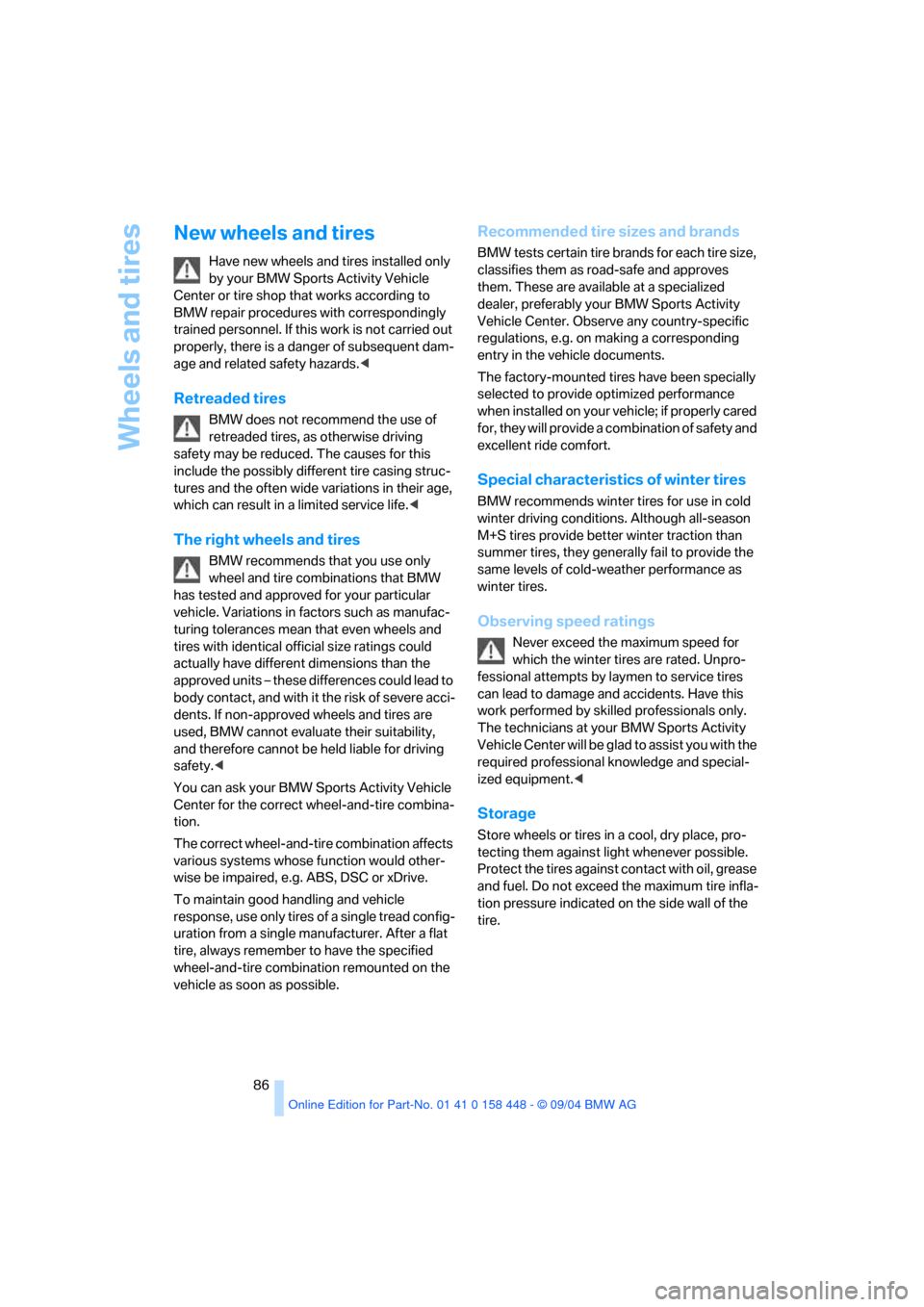
Wheels and tires
86
New wheels and tires
Have new wheels and tires installed only
by your BMW Sports Activity Vehicle
Center or tire shop that works according to
BMW repair procedures with correspondingly
trained personnel. If this work is not carried out
properly, there is a danger of subsequent dam-
age and related safety hazards.<
Retreaded tires
BMW does not recommend the use of
retreaded tires, as otherwise driving
safety may be reduced. The causes for this
include the possibly different tire casing struc-
tures and the often wide variations in their age,
which can result in a limited service life.<
The right wheels and tires
BMW recommends that you use only
wheel and tire combinations that BMW
has tested and approved for your particular
vehicle. Variations in factors such as manufac-
turing tolerances mean that even wheels and
tires with identical official size ratings could
actually have different dimensions than the
approved units – these differences could lead to
body contact, and with it the risk of severe acci-
dents. If non-approved wheels and tires are
used, BMW cannot evaluate their suitability,
and therefore cannot be held liable for driving
safety.<
You can ask your BMW Sports Activity Vehicle
Center for the correct wheel-and-tire combina-
tion.
The correct wheel-and-tire combination affects
various systems whose function would other-
wise be impaired, e.g. ABS, DSC or xDrive.
To maintain good handling and vehicle
response, use only tires of a single tread config-
uration from a single manufacturer. After a flat
tire, always remember to have the specified
wheel-and-tire combination remounted on the
vehicle as soon as possible.
Recommended tire sizes and brands
BMW tests certain tire brands for each tire size,
classifies them as road-safe and approves
them. These are available at a specialized
dealer, preferably your BMW Sports Activity
Vehicle Center. Observe any country-specific
regulations, e.g. on making a corresponding
entry in the vehicle documents.
The factory-mounted tires have been specially
selected to provide optimized performance
when installed on your vehicle; if properly cared
for, they will provide a combination of safety and
excellent ride comfort.
Special characteristics of winter tires
BMW recommends winter tires for use in cold
winter driving conditions. Although all-season
M+S tires provide better winter traction than
summer tires, they generally fail to provide the
same levels of cold-weather performance as
winter tires.
Observing speed ratings
Never exceed the maximum speed for
which the winter tires are rated. Unpro-
fessional attempts by laymen to service tires
can lead to damage and accidents. Have this
work performed by skilled professionals only.
The technicians at your BMW Sports Activity
V e h i c l e C e n t e r w i l l b e g l a d t o a s s i s t y o u w i t h t h e
required professional knowledge and special-
ized equipment.<
Storage
Store wheels or tires in a cool, dry place, pro-
tecting them against light whenever possible.
Protect the tires against contact with oil, grease
and fuel. Do not exceed the maximum tire infla-
tion pressure indicated on the side wall of the
tire.
Page 102 of 126
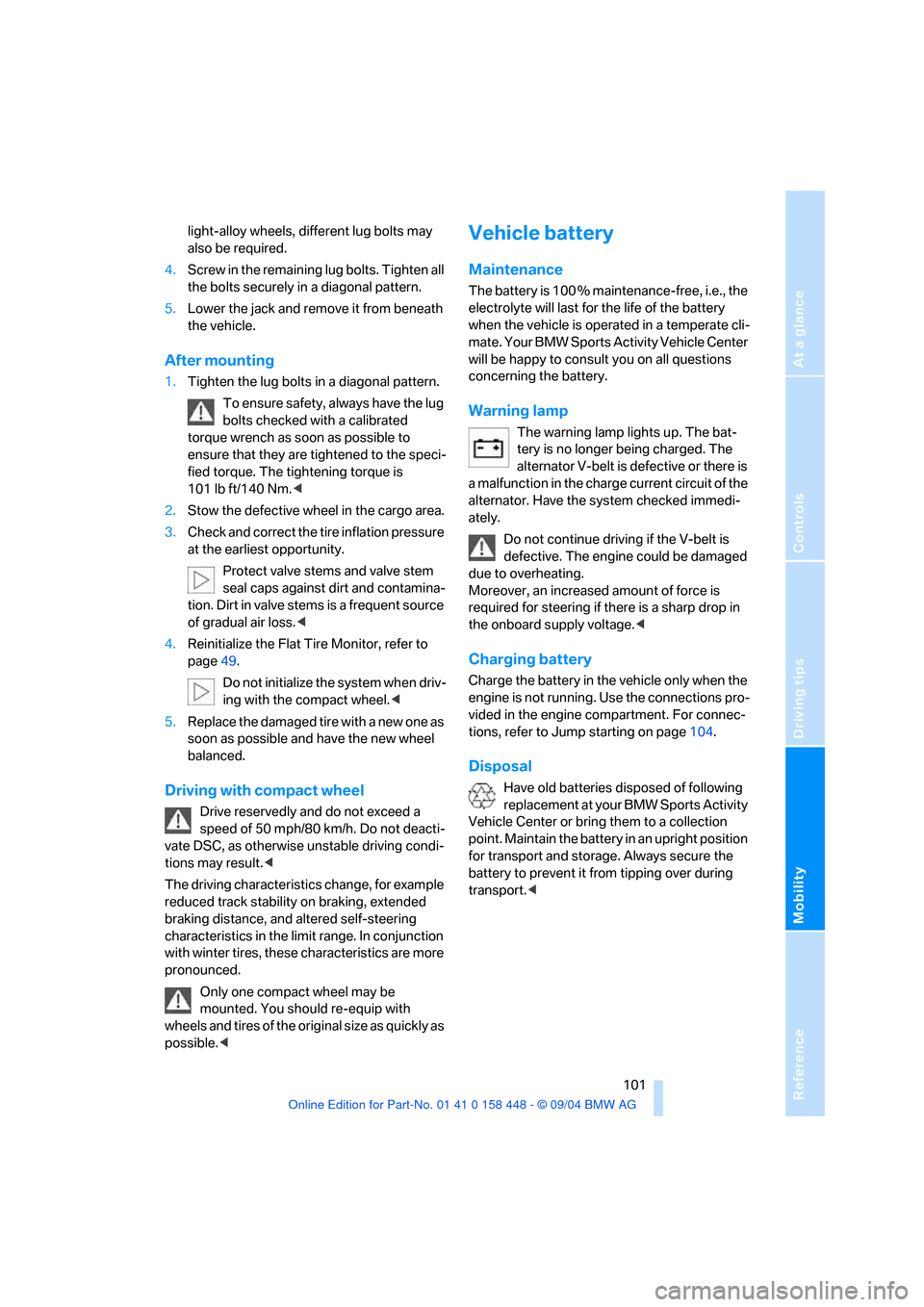
Reference
At a glance
Controls
Driving tips
Mobility
101
light-alloy wheels, different lug bolts may
also be required.
4.Screw in the remaining lug bolts. Tighten all
the bolts securely in a diagonal pattern.
5.Lower the jack and remove it from beneath
the vehicle.
After mounting
1.Tighten the lug bolts in a diagonal pattern.
To ensure safety, always have the lug
bolts checked with a calibrated
torque wrench as soon as possible to
ensure that they are tightened to the speci-
fied torque. The tightening torque is
101lbft/140Nm.<
2.Stow the defective wheel in the cargo area.
3.Check and correct the tire inflation pressure
at the earliest opportunity.
Protect valve stems and valve stem
seal caps against dirt and contamina-
tion. Dirt in valve stems is a frequent source
of gradual air loss.<
4.Reinitialize the Flat Tire Monitor, refer to
page49.
Do not initialize the system when driv-
ing with the compact wheel.<
5.Replace the damaged tire with a new one as
soon as possible and have the new wheel
balanced.
Driving with compact wheel
Drive reservedly and do not exceed a
speed of 50 mph/80 km/h. Do not deacti-
vate DSC, as otherwise unstable driving condi-
tions may result.<
The driving characteristics change, for example
reduced track stability on braking, extended
braking distance, and altered self-steering
characteristics in the limit range. In conjunction
with winter tires, these characteristics are more
pronounced.
Only one compact wheel may be
mounted. You should re-equip with
wheels and tires of the original size as quickly as
possible.<
Vehicle battery
Maintenance
The battery is 100 % maintenance-free, i.e., the
electrolyte will last for the life of the battery
when the vehicle is operated in a temperate cli-
mate. Your BMW Sports Activity Vehicle Center
will be happy to consult you on all questions
concerning the battery.
Warning lamp
The warning lamp lights up. The bat-
tery is no longer being charged. The
alternator V-belt is defective or there is
a malfunction in the charge current circuit of the
alternator. Have the system checked immedi-
ately.
Do not continue driving if the V-belt is
defective. The engine could be damaged
due to overheating.
Moreover, an increased amount of force is
required for steering if there is a sharp drop in
the onboard supply voltage.<
Charging battery
Charge the battery in the vehicle only when the
engine is not running. Use the connections pro-
vided in the engine compartment. For connec-
tions, refer to Jump starting on page104.
Disposal
Have old batteries disposed of following
replacement at your BMW Sports Activity
Vehicle Center or bring them to a collection
point. Maintain the battery in an upright position
for transport and storage. Always secure the
battery to prevent it from tipping over during
transport.<
Page 114 of 126
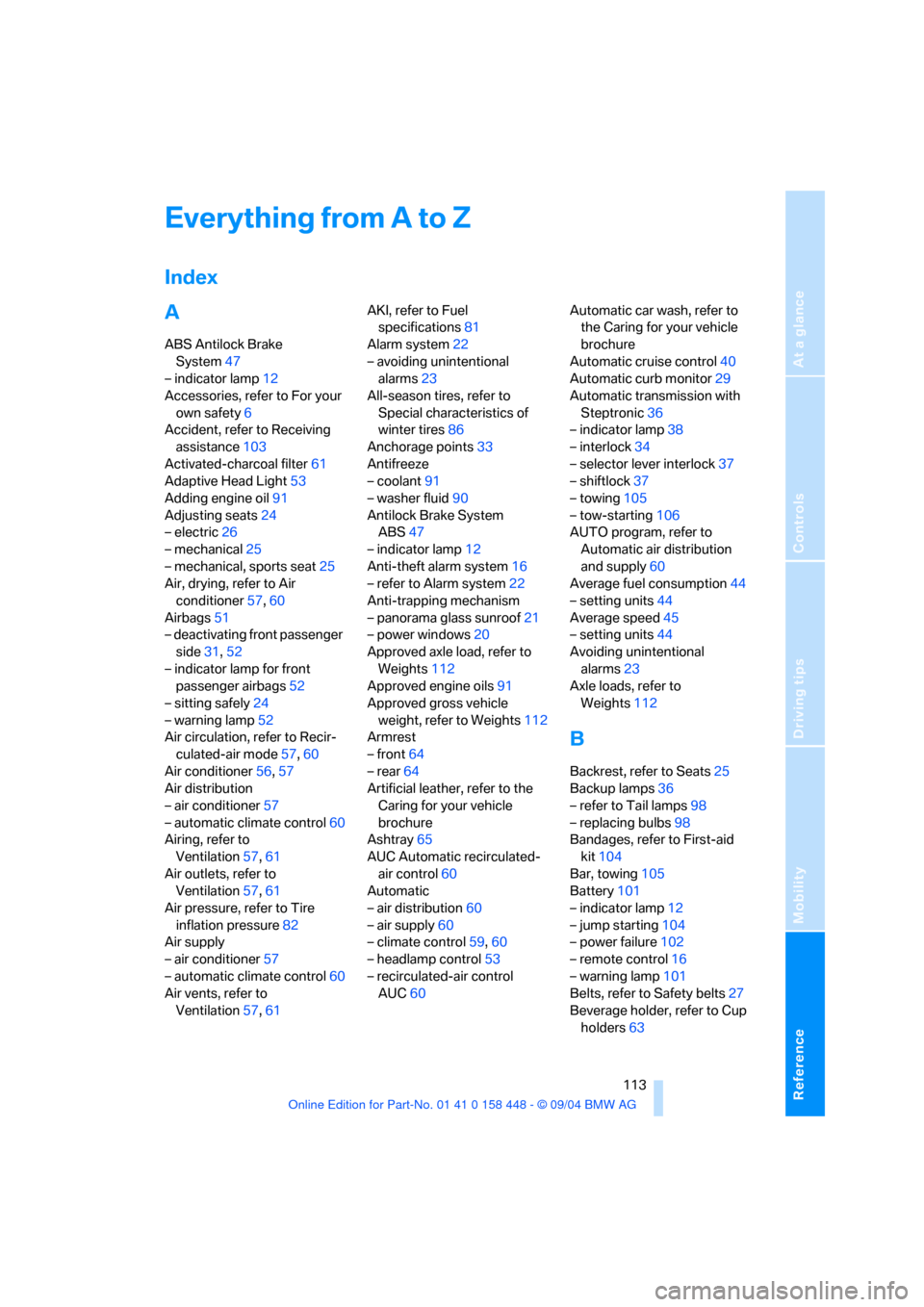
Reference
At a glance
Controls
Driving tips
Mobility
113
Everything from A to Z
Index
A
ABS Antilock Brake
System47
– indicator lamp12
Accessories, refer to For your
own safety6
Accident, refer to Receiving
assistance103
Activated-charcoal filter61
Adaptive Head Light53
Adding engine oil91
Adjusting seats24
– electric26
– mechanical25
– mechanical, sports seat25
Air, drying, refer to Air
conditioner57,60
Airbags51
– deactivating front passenger
side31,52
– indicator lamp for front
passenger airbags52
– sitting safely24
– warning lamp52
Air circulation, refer to Recir-
culated-air mode57,60
Air conditioner56,57
Air distribution
– air conditioner57
– automatic climate control60
Airing, refer to
Ventilation57,61
Air outlets, refer to
Ventilation57,61
Air pressure, refer to Tire
inflation pressure82
Air supply
– air conditioner57
– automatic climate control60
Air vents, refer to
Ventilation57,61AKI, refer to Fuel
specifications81
Alarm system22
– avoiding unintentional
alarms23
All-season tires, refer to
Special characteristics of
winter tires86
Anchorage points33
Antifreeze
– coolant91
– washer fluid90
Antilock Brake System
ABS47
– indicator lamp12
Anti-theft alarm system16
– refer to Alarm system22
Anti-trapping mechanism
– panorama glass sunroof21
– power windows20
Approved axle load, refer to
Weights112
Approved engine oils91
Approved gross vehicle
weight, refer to Weights112
Armrest
– front64
– rear64
Artificial leather, refer to the
Caring for your vehicle
brochure
Ashtray65
AUC Automatic recirculated-
air control60
Automatic
– air distribution60
– air supply60
– climate control59,60
– headlamp control53
– recirculated-air control
AUC60Automatic car wash, refer to
the Caring for your vehicle
brochure
Automatic cruise control40
Automatic curb monitor29
Automatic transmission with
Steptronic36
– indicator lamp38
– interlock34
– selector lever interlock37
– shiftlock37
– towing105
– tow-starting106
AUTO program, refer to
Automatic air distribution
and supply60
Average fuel consumption44
– setting units44
Average speed45
– setting units44
Avoiding unintentional
alarms23
Axle loads, refer to
Weights112
B
Backrest, refer to Seats25
Backup lamps36
– refer to Tail lamps98
– replacing bulbs98
Bandages, refer to First-aid
kit104
Bar, towing105
Battery101
– indicator lamp12
– jump starting104
– power failure102
– remote control16
– warning lamp101
Belts, refer to Safety belts27
Beverage holder, refer to Cup
holders63